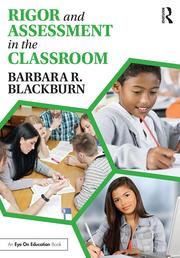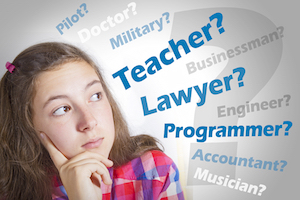Helping Students Pursue Dreams of Success
 By Barbara Blackburn
By Barbara Blackburn
“Never give anyone permission to take away your chance for success.” – Sam Myers, Alternative School Coordinator, Sumter (SC) District 17
Ronita, one of my former students, generally struggled in class. One day, after much hard work and studying, she made an A on a project. I was so proud of her but was stunned at her response. First, she said she was “lucky.” After I assured her that wasn’t true, she thanked me for “giving” her an A.
She just didn’t get it; the A wasn’t because of any outside force (luck or me), it was her; her efforts had earned the grade.
Unfortunately, many students are like Ronita. They don’t have a strong internal locus of control—an inner confidence that they have choices and are in control of their behavior.
When researchers compare people who are successful in an area of life (business, sports, etc.), they have one thing in common: Each has a clear vision for their life and a strong belief that they can achieve their dreams, that they are in control of their own destiny.
Failed dreamers blame outside forces
Compare that to people who find themselves simply existing from day to day. At some point, they look back at their life and ask, “How did I end up here? When I was young, I dreamed of [………].”
As you talk to them, they will say things such as, “I wanted to be a musician, but someone else won the competition.” “I tried to get the promotion, but my boss doesn’t like me.” “I could have been a pro athlete, but no one gave me a chance.” You can tell from the language; it’s always about someone or something else. They view control as external, or outside themselves. It’s always about other people or circumstances.

There are many societal elements that encourage this attitude. Did you get in a fight? The other person started it, so you didn’t have a choice. Did you miss out on a bonus? The system is unfair. Did you commit a crime? It was because you watch television. The “excuses mentality” undermines having an internal sense of control.
Self-empowerment is about encouraging students to believe in themselves. We do that by giving students two clear messages:
- Whether you succeed or fail is up to you. Period.
- You need to have a dream or vision that is the basis for your everyday choices and decisions.
Structures to encourage self-empowerment
One of the most basic ways to encourage the internal sense of control is to simply not allow any expressions of a lack of control. I never allowed students to use the phrase “I can’t” in my classroom, telling them “You may choose not to try or you may not want to or you may not be there yet, but saying you can’t simply isn’t an option.”
It took several weeks, but the students really bought into it. Again, I was unable to make them believe in themselves, but I refused to reinforce their lack of belief.
Belief building is critical. I have a strong belief that I can tackle any challenge. A friend asked me how I became so confident; where or when did I get my belief that I could achieve my dreams? My belief in myself is built on a strong base of memories.
First, I have countless memories of people who believed in me and shared that belief with me. My parents, my grandparents, former teachers, friends—the list is long. Their encouragement helped me learn to believe in myself, even when I wasn’t successful with a project.
Second, based on their support, many times I persisted through failure until I succeeded. The memories of those successes give me the strength to attempt the next challenge.
 Your students need the same memories. They will remember the times you show them you believe in them. Students remember the smiles, the kind words, and the opportunity and encouragement to try again when they fail. Imagine if all teachers did that!
Your students need the same memories. They will remember the times you show them you believe in them. Students remember the smiles, the kind words, and the opportunity and encouragement to try again when they fail. Imagine if all teachers did that!
But students sometimes forget the successes they achieve. When my students are struggling with an assignment, I’m quick to remind them of the other times when a project seemed difficult but was finished successfully. That’s the essence of belief building: helping students realize their own potential.
Making dreams real: writing a theme song
You can encourage your students to have a dream through classroom activities. For example, you can have students write about their dreams: What do you want to be when you grow up? Kendra Alston has her students choose or write a theme song for their lives. Here’s Da’nisha Strong’s song:
Survivor
Now, that I made my goal, I’m so much better!
I made it through the stormy weather
The spring social Oh!
Was so much fun, and the talent show when AJ sung!
When KAOS kick that beat Survivor
field day was a treat
Friday night live was such a hit!
When it was over we had a fit!
I’m a survivor
I didn’t give up
I couldn’t stop
I had to work harder
I’m a survivor
I’m glad I made it!
I had fun and I’m going to keep on surviving.
Many Olympic and professional athletes say they write their dreams on a card, and then look at it every morning to reinforce it. For example, I received an e-mail with this quote from actor and former California Gov. Arnold Schwarzenegger: “I have my vision of what I want California to be and I don’t care what it takes to make it reality. People used to ask me about how I could spend 5 hours a day lifting weights and doing the same sit ups over and over. It’s simple. I see my vision very clearly and then I do whatever it takes to make it happen.”

That’s why it’s important to write your dream; writing it down makes it real and helps you achieve it. Let your students be creative. The important thing is to give them the opportunity to dream and to express those dreams.
Modeling
A third part of a dream-building classroom is to model having and achieving dreams. That starts with sharing your own dreams.
If your dream is to write an article about your teaching, tell your students about it. If your dream is to travel to a new place, put a picture up near your desk so they (and you) will be reminded of it.
Read stories in class about people and their dreams and goals for their lives. It’s important to talk about people who achieved their dreams despite failures.
When possible, bring in speakers or resource materials that are linked to your students’ dreams. For example, if you have a student who wants to be a painter, find a local artist to come into your classroom. If several of your students want to be pro basketball players and you don’t have a pro star handy, bring in the star of the high school or college team. You’ll be amazed at how much of a role model they can be for your students and how honored they are to be asked.
I’ve been in several school districts recently that have AVID (Advancement Via Individual Determination) classes. The program provides academic support in grades 5 to 12 for students who are typically performing at an average level but are capable of higher levels of performance.
One of AVID’s goals is to “level the playing field for minority, rural, low-income, and other students without a college-going tradition in their families.” Janet Gonski, an AVID teacher at Crofton Middle School, described the goal as to “support them on the bottom so they can fly to the top.” This is our goal for all of our students, to help them move beyond their limits.
It’s up to you
Helping students believe in themselves is a critical part of teaching. Structuring your classroom to encourage believing in yourself is easy to do, as long as you dream about it, plan for it, and carry it through.
See a related MiddleWeb post about “learned helplessness.”
__________
 Barbara Blackburn is a best-selling author of 15 books including Rigor is Not a Four Letter Word. A nationally recognized expert in the areas of rigor and motivation, she collaborates with schools and districts for professional development. Barbara can be reached through her website or her blog. She’s on Twitter @BarbBlackburn. Her latest books are 2017’s Rigor and Assessment in the Classroom and the 2nd edition of The Principalship from A to Z, written with Ron Williamson.
Barbara Blackburn is a best-selling author of 15 books including Rigor is Not a Four Letter Word. A nationally recognized expert in the areas of rigor and motivation, she collaborates with schools and districts for professional development. Barbara can be reached through her website or her blog. She’s on Twitter @BarbBlackburn. Her latest books are 2017’s Rigor and Assessment in the Classroom and the 2nd edition of The Principalship from A to Z, written with Ron Williamson.



































What you describe in psychological terms is called efficacy belief and it applies to us all. In my dissertation studying what makes teachers think they can, the most important factor across public, charter, parochial and private school teachers was collegiality! When we work together with others to solve problems we can accomplish so much more. I love the AVID description as that is so key for so many individuals to be able to imagine that pathway. One factor left out is physiological state.. you can believe more easily in yourself if you are not too tired, or hungry –meaning students have to learn self care as well. I always have a fruit basket available for my middle schoolers’ appetites….sometimes that next lunch period is too far away. Thank you for an excellent article.
I very much enjoyed reading and relating to your article.